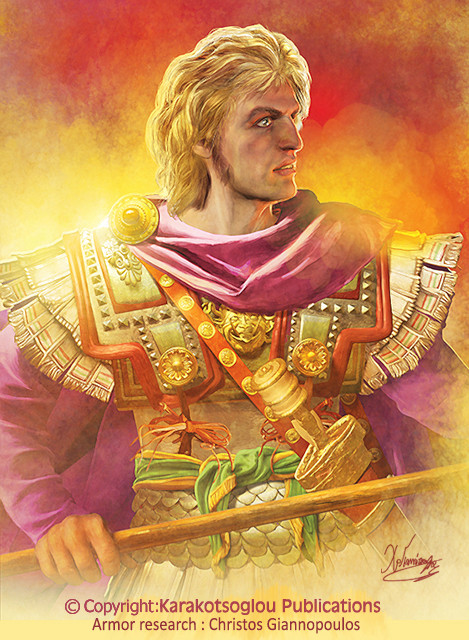HOME | DD
 ChrisHistoryartworks — Attila The Hun
ChrisHistoryartworks — Attila The Hun

#armor #bow #goths #history #hun #illustration #mail #military #war #archer #asian #attila #barbarian #dagger #empire #german #helmet #javelin #lamellar #militaryuniform #mongolia #nomad #spear #steppe #sword #warrior #militaryhistory #historyart
Published: 2021-06-18 17:09:07 +0000 UTC; Views: 17719; Favourites: 204; Downloads: 50
Redirect to original
Description
Commissioned artwork and armor research created and published in Greece in 2005
©2005 Christos Giannopoulos
The escalation of barbarian migrations in late antiquity brought to the fore the weakness of both the western and eastern Roman empires, to defend their extensive borders against more and more invaders “materializing” along the Danube. Centuries before the advent of Genghis Khan, another Turko-Mongoloid leader associated his name with utter desolation, total massacre and the eschatological apocalyptic predictions for the dark fate of the world: Attila, the "scourge of the god", the absolute ruler "Khagan" of the western Huns, and Sovereign of the Ostrogoths, Gepids, Alans and numerous German and Iranian speaking populations along the Danube and the Eurasian steppe.
The image of Attila and the western Huns was of course created through the nightmares and prejudices of the historians of the urbanized Mediterranean, who saw the filthy and primitive equestrian nomads of the east as a declining hybrid of human evolution feeding on the corpse of civilization. For every cultured bourgeois of the Roman Empire, Attila's Huns, were in Roman minds ugly, scar faced demons pouring out of Erebus and the Chaos that preceded the dawn of time. But again the Huns and their Germanic – Iranian vassals might have remained an occasional threat if Attila had failed to unite them in 445 AD and create the first barbarian empire to threaten both Rome and China!!! Unfortunately only fragments remain of testimonies about the Attila and his appearance, the most important being that of Priscus –a Byzantine diplomat and historian, a member of the embassy of emperor Theodosius II at Attila’s headquarters in 449, and therefore an eye witness and the only person known to have recorded a physical description of him, stating that he was broad chested and broad faced, with small eyes, his beard thin and sprinkled with grey, flat nosed and with tanned skin… Jordanes stressed that the Huns were short of stature, had tanned skin and round and shapeless heads. Although there was a trend to identify the Huns with the ancient Xiongnu nomads (active in Mongolian territory) neither this theory ever gained universal acceptance among the historians nor the fact that the Hun tribal confederation of Attila’s era was clearly East Asian in physical appearance (or mostly Caucasian for others) ever prevailed. Many facts about Hun anthropology or origins are still in debate.
Armor research: The particular depiction of Attila intended to present the leader of Huns and various Germanic – Iranian people in the peak of his power around mid- 5th century AD, as he was fascinated by Roman splendor and desired to surround himself with imperial aura, none the less remaining a formidable warrior high king of nomadic origin. The Hun arsenal is described in late antiquity sources and so their tactics. Huns were primarily horse archers and secondary users of lance and javelin. Attila wears a “three quarter” lamellar Xiongnu style body armor, short sleeved mail cuirass, segmented Iranian arm defenses and an Ostrogothic iron “spagenhelm” with bronze reinforcements on the dome and lamellar neck guard. The long lamellar thigh guards and the horse hair crest make the medium stature Attila look taller. His round shield is not a standard cavalry item but it could be used in “dismounted” confrontations. His Iranian style straight bladed sword with diamond shaped guard is adorned with gold. The sword pommel is decorated with ceremonial blue “lapis lazuli” gem, a princely Hun element. Of royal status is also the golden inlaid bow the king holds in his right hand. He also carries two extra bows in a leather case and a quiver adorned with gold hangings. Other aggressive weapons are the spear, javelin and the Hun single edge dagger hanging horizontally from the adorned waist belt. It is believed by many researchers that the Hun dagger is the predecessor of the Saxon “seax”.
Related content
Comments: 7

👍: 0 ⏩: 0

👍: 0 ⏩: 0

👍: 1 ⏩: 0

👍: 0 ⏩: 1

👍: 0 ⏩: 0

👍: 1 ⏩: 1

👍: 0 ⏩: 0
























